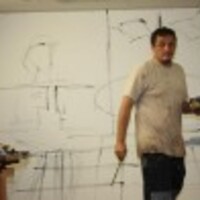Maciej Hoffman
The paintings from the cycle "Marketing Civilization" are my own observations of the contemporary style and content of life looked at from the perspective of the necessity and omnipresence of consumption. Our needs were mostly reduced to intellectually comfortable and psychologically exhausting contenting ourselves with the consumption of the world instead of giving something from ourselves to create the world. Our everyday lives became dominated by work and pursuit of products attacking us from the store shelves and by the pictures that are generated for the needs of this invasion. The reality under the thumb of the economy gave birth to a culture which would rather sell images created by others than create its own ones.
The works belonging to this cycle refer to the composition of press advertisements and to the search for a stronger influence on people. Thus the poster-like flatness of the background and the strong color which, in the marketing world, is supposed to make the message clearer and attract to the product. It is my attempt of drawing the attention to what the world looks like from this perspective.
In the exhibition I present the triptych: "Dwarf”, "For rent" and "Target group", which is to touch on how the advertisements ruthlessly use the symbols and appropriate them for commercial needs. Symbols and authorities which are deeply rooted in our consciousness are a pretext for pushing you any product, a beverage, a screw or even “an independent opinion” just by putting in the ad a man dressed up in a white lab-coat or wearing a dog collar .
On the other hand, we all function in this reality, with relationships built by the marketing and advertisement world which can be brought down to the fact that you always find yourself in one of the roles, a buyer, a seller or a person being sold. You can indeed exist as a product. Your absence in this chain of relations condemns you to a kind of nonexistence.
Maciej Hoffman
I thought that it could be an interesting trend to present artists who made their debut in the 1980’s and then got lost somewhere, they started doing something else instead. After some years they returned to the creative activities. Maciej Hoffman is one of such artists who did some painting but did not treat it too seriously as he was occupied with other matters, which were at that time of more importance to him. He had an episode with a company named “Zebra”. He returned to painting. These issues interest me very much not only from the artistic but also from the psychological side. I think that the way chosen by Maciej Hoffman is a way pursued by many artists belonging to this generation.
Dorota Wrzesińska,
Na Solnym Gallery in Wrocław
What is striking in Maciej Hoffman’s paintings is particularly their pugnacity. It is the courage in the way he operates with the color, material and texture. This pugnacity is valuable as it is courageous. There is the directness. There is not a moment of reflection about whether it is right or wrong. There is a human impulse. The painting speaks for itself. That is the force that convinces us, the viewers, that the artist knows what he is doing. His paintings are ‘intercepted’ by the viewers. I observe it in the gallery. This pugnacity, this impetuousness, this revolt is like a conquest of man. There is no manipulation, calculation or smuggling of anything. This is how I see it.
Janusz Golik, graphic artist, the owner of van Golik Gallery in Warsaw
Looking at Maciej Hoffman’s paintings we can try to define what is good painting. What is good art. Good painting, good art comes from a clear flow of energy. The energy comes from the universe through the artist and his works to the viewer. The less the flow is disturbed the better work is created. In the paintings by Hoffman it is visible that the energy comes through. Of course, you could think about the details. Maciej Hoffman is on the right way but he should, in my opinion, think about the meaning of geometrical shapes in his painting. He should carefully reconsider it. With all the freedom that he is presenting, here and there his works become dominated by the geometrical shapes. Should they be given such importance? Or maybe it would be better to show more freedom, conciseness and nonchalance? Personally, I would rather relax it more, releasing even more energy.
Zdzisław Majrowski, painter
In Maciej Hoffman’s paintings I feel the energy, freedom, uncontrollable emotions and loneliness. I see the pursuit of liberty, the rebellion and zeal. Andre Gide wrote, “To love without caring if it is good or wrong, Nathanel, I will teach you the ardor(…) Throw my book Nathanel. Free yourself from it.” For me Maciej Hoffman’s art is a liberation from all the life’s and world’s ‘books’. The cracking of the contemporary world makes us plunge into darkness. This painting is an arduous way out into light. Catharsis?
Emilia Krakowska, an actress
If we assume that art is a recreation of reality then Maciej Hoffman certainly is not afraid to interpret the terror of this reality. If we assume that art is creating beauty then Hoffman does not hesitate to look for it among the terror. His painting is strong, emotional ranging between the space and the color. For me it is close to the best period of Polish theatrical stage decoration (Szajna). It leaves a sense of uncertainty. Where will it lead the artist? Of course, I do not know it and nobody does. What is important is that we would like to know. I believe that for the author to inspire such curiosity of the viewer is a success, even if it is not necessarily deliberate.
Walentyna Mikołajczyk-Trzcińska, a writer

